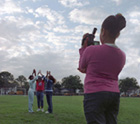
Filming Desire: A Journey Through Women’s Cinema 2000
Distributed by Women Make Movies, 462 Broadway, New York, New York 10013; 212-925-0606
Produced by SAGA Film (Brussels) and the factory (Paris), in co-production with ARTE and the RTBF
Directed by Marie Mandy
VHS, color, 60 min.
College - Adult
Film Studies, Gender Studies, Women's Studies
Date Entered: 11/09/2018
Reviewed by Jean O’Reilly, University of ConnecticutThis multilingual documentary has English subtitles. The interviewees are Agnès Varda, Jeanne Labrune, Catherine Breillat, Paule Baillergeon, Francesca Comencini, Jane Campion (very briefly), Sally Potter, Léa Pool, Doris Dörrie, Liliana Cavani, Deepa Mehta, Patricia Rozema, Moufida Tlatli, Safi Faye, and Carine Adler.
The film begins with the hypothesis that female and male directors film desire -- love, lust, relationships, sex -- differently. The hypothesis is never proved because Mandy doesn’t establish cinema’s male viewpoint, with which the female viewpoint must be compared. Nevertheless, this film is full of valuable information for film students and gender and women’s studies scholars alike. By giving several filmmakers a chance to discuss their work, Filming Desire demonstrates that there is no such thing as a generic female filmmaker.
The film consists largely of a series of interviews with female filmmakers from several different countries and filmmaking eras. Some, such as Agnès Varda and Catherine Breillat (both from France), have been making films for decades in a conscious effort to provide an alternative to the male filmmaking model; others, such as Moufida Tlatli (Tunisia) and Carine Adler (England), are relative newcomers to directing, and their approaches seem more personal and less political. The film as a whole manages to cover some important topics in the feminist debate about film -- how does one construct a female gaze, how can one film nude bodies without objectifying the actors (of either sex), what constitutes a strong female role -- while also making it clear that “women’s film” comprises as many different approaches to filmmaking as there are female filmmakers.
The most useful element of this film is the filmmakers’ analyses of scenes from their own films, which are presented as voiceovers to the scenes themselves. The filmmakers sometimes stumble over Mandy’s questions about the filming of desire (the brief interview with Jane Campion is particularly awkward) but when they turn to their own films they provide intelligent and cogent analyses of crucial scenes. The viewer not only sees each scene from its creator’s viewpoint but also sees how some of the feminist (and not so feminist) ideas behind those viewpoints play out on the screen.
Technical quality is good: this is a handsome film with adequate subtitling and clear sound. It’s difficult to read the subtitles while watching the film clips, but that’s always the risk with subtitles. Intertitles break the film into several segments, but the titles themselves (“Body,” “Desire-Love”) are more confusing than illuminating.
The film assumes the viewer’s familiarity with the directors being interviewed. Introductions are short and coy, often providing no more than a name, number of films produced, and number of children. Instructors will want to supplement that information.